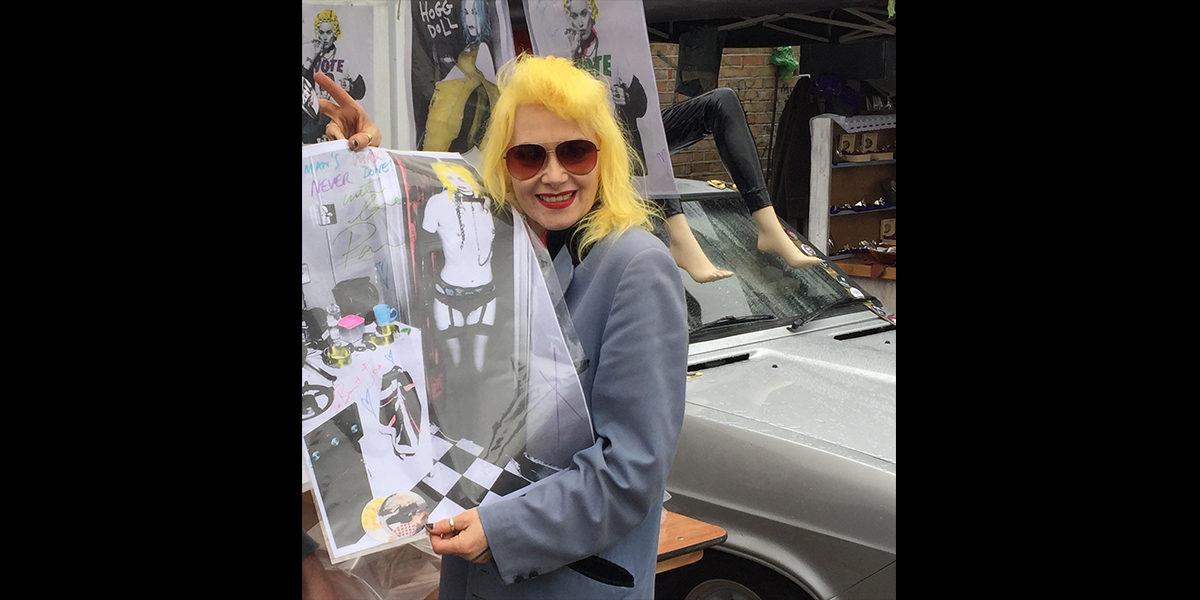Pam Hogg, the Scottish designer, artist, musician and renegade spirit who spent four decades blowing holes in the polite boundaries of British fashion, has died. Her family announced the news with a quiet, stunned sadness on Instagram, saying she passed “peacefully” at St Joseph’s Hospice in Hackney, surrounded by friends and family who adored her. No cause of death was given. Hogg, who kept her age deliberately off-limits—“it’s nobody’s business,” she once told the Guardian—is believed to have been in her sixties.
For many, the name Pam Hogg lands like a flash of neon: the wild, outlandish shapes; the catsuits so sharp they looked engineered rather than sewn; the shock of colour, always colour, as if London’s punk years had never drained away but kept mutating through her. Rihanna wore her. Kate Moss, too. So did Gaga, Kylie, Björk, Naomi Campbell, Siouxsie Sioux, and Grace Jones. A strange, eclectic constellation—precisely the kind of rebellious court a designer such as Hogg deserved.
She came out of Paisley, stitched her first oddball creations from the hand-me-downs of neighbours who “weren’t rich, just better off than us,” and fashioned a look long before she considered it a career. Glasgow School of Art gave her the formal language. The Royal College of Art sharpened it. And then, in 1981—right in the heat of Post-Punk London—she dropped Psychedelic Jungle, her first real collection, a riot of strict clubwear and Blitz-era glam smashed together. It was less a debut, more a declaration.
By the late ’80s, she had her own boutique off Carnaby Street, and by the ’90s, she was already orbiting the mythology of London fashion: obstinate, magnetic, impossible to ignore. She wore her work, lived inside it. Platinum wigs one year, sci-fi armour the next. A visual identity not so much crafted as inhabited—like she was her own muse, editor, model, and frontwoman, which of course she also was.
Designer Kim Jones called her a “warrior queen” who remained fiercely strong until the end. Bella Freud mourned the thought of a fashion landscape without Hogg’s “shining brilliance.” Gwendoline Christie, Andi Oliver, Shirley Manson—voices from music, fashion, culture—lined up to salute her. Manson said it best: Hogg was “our revered Scottish fashion queen,” driven by “brilliance and bravery and an explosive sense of humour.”
But it wasn’t just the clothes or the spectacle. Hogg had an instinct for mythmaking, for turning garments into armour and persona into theatre. Her catsuits—tight, audacious, shimmering like alien skin—were not just garments but declarations of bodily autonomy, swagger, and refusal. That became her signature, and she never strays from her values.
Her work crossed boundaries effortlessly. She designed the BRIT Awards trophy in 2016—thirteen glittering, metallic avatars of her imagination. She made music, supported Debbie Harry and The Pogues, then formed her own band, Doll. She painted, sculpted, and performed. Categories were always too small for her; she expanded past them without asking permission.
Even royalty dipped a toe into Hogg’s universe. Princess Diana wore one of her dresses. Princess Eugenie wore another to Ascot. Hogg never softened her edge for anyone—not even the palace. For years, she participated in the Art Car Boot Fair, where you could buy her glitter-covered screenprints.
Her family’s statement, tender and slightly raw, said her “creative spirit… touched the lives of many people of all ages,” and that she leaves behind “a magnificent legacy”, urging us all “to live beyond the confines of convention.”
Pam Hogg built worlds, tore holes in fashion’s conformity, and insisted—loudly—that imagination was a right, not a luxury. She lived gloriously, ferociously, and entirely on her own terms. And now, suddenly, unbearably, she is gone. But she’s not faded. She won’t. Hogg’s legacy is stitched into the brightest seams of British culture, still vibrating with colour.
Top Photo: P C Robinson © Artlyst 2025

